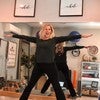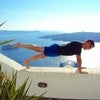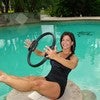Description
About This Video
Transcript
Read Full Transcript
Hi, I'm Michael King. Welcome back to Pilates Anytime. And today I'm teaching a program on sequencing on the reformer. I come from a very traditional background. And doing the movements 10 or 20 times, depending on the movement, gives you an opportunity of really learning the movements.
When we start sequencings, you need to have gone through that progress first so that when you start putting the program together, you know the details. So today I'm going to be showing you just how to build it over a series, a period of weeks or months, even sometimes, depending on which class you're teaching. I teach now with most the time, when your spine is in neutral on the reformer, whereas I used to teach very imprinted, very traditionally. But since about 1999 or 2000, obviously, we know a lot more information about working the back muscle. So when we're working in the leg series, the back is maintaining a neutral spine.
Also, as far as the headrest is concerned, I see that as a modification. If somebody doesn't need the headrest up, I keep the headrest in line so it meets their posture. So sometimes if somebody is a little bit more kyphotic and the head is back, then, of course, you would need the to face the headrest into the position of either small elevated lift, or even sometimes, if that's too much, just using a towel. The other thing which I find is very important today, is that we focus on the ankle stability. So most of the time when we're working on the toes, we want to work in what I call, when I'm teaching, a neutral ankle position.
So from a lifted point to a flexed foot, we take the ankle to midway point with the least stress on that ankle joint. So, for a client, it's very easy to understand neutral spine, neutral pelvis, neutral ankle. And we're going to be moving those together as we're working the reformer. With the springs as well, I want to get the most benefit out of all the movements. So if somebody pushes away on the reformer, I want them to work with the quality of movement on the extension, breathing out as they push away, but also as they return.
I find it very easy for clients just to relax. So often what you'll see clients doing is push away, but then relaxing, and letting the springs pull them back down. A tip I always tell my clients is you're not getting the value for money. You're wasting some of your money. Get all the value from your session by using the springs on that return.
So I'm going to show you the sequences as I would build them. We're going to start with a leg series. So we're going to start in the first position, or a V turned out. So neutral spine, neutral pelvis, we're going to elongate the spine. And every time we do the movement, we're going to keep that elongation.
The shoulder blades drop down. And the pelvis work stays in that fixed neutral position. I'm going to work with what I call a protected breath first. Breathing out as you push away. So breath is going to help with the stability of the center.
So every time, I want the client to think about the length of the spine. Every time they push away, just to depress or let the shoulder blades drop down, maintaining that core connection, keeping the ankle stability, breathing out, and breathing in. Now as this is a movement machine, I want the movement to be continuous, reminding the clients all the time about the flow and about the principles. So flowing movement, continuous movement. Breathing out to extend, breathing in to come back.
So we're going work now on the first sequence. We're going to do one leg extension, coming back down. The next time, we're going to push away, keep the leg extension and keep the legs straight, and then slowly roll forward into a seated position. Roll back down. And then bend those knees and come down.
So the first thing is a roll up and a leg series put together, breathing out as you extend, breathing in, breathing out as you roll forward. Lengthen the spine tall, breathing in, breathing out as you roll down. And slowly come back down. Now sometimes, depending on what the client's wearing, sometimes they might slip. So today were using a non-slip pad underneath the pelvis.
And that's going to help the client from not slipping backwards on the reformer. If it really becomes a problem, then you could always just hold the base of the reformer just slightly with the fingertips so when they roll up and roll down, they don't push against the shoulder pads. So this is the first two movements. Breathing out, take a breath in. Slowly breathing out, roll forward.
Lengthen up, breathing in. Breathing out, rolling down. And then slowly bending the knees and coming down. Now, a way of challenging this a little bit further, is instead of doing this with straight legs, it's to do an extension and then come halfway down. Now, halfway down, we're going to fix the carriage.
We're going to fix the carriage. And then we're going to slow roll up and then roll back down without the carriage moving and then coming all the way back down. Now, of course, we need the flexibility in the spine to be able to do this. So the people with very tight lumbar spines are probably going to feel it best to do it with their legs straight. People who have got that flexibility can challenge the core a little bit more by now fixing the carriage, rolling up, lengthening, rolling back down without any movement of carriage.
And then slowly come back down. So let's add to this now. We're going to add the third part of the sequence. Slowly, push away. Roll up with straight legs first.
Now slowly come back down. And then roll back down. Let's do that again with a stomach massage adding on. Push away. Slowly roll out.
Now, keeping the spine long, keeping elevated, bend those knees, come down. And let's do five stomach massages, pushing away. Again, we're keeping a neutral spine. So we're not doing this in a traditional classical flexed position. We're challenging those back muscles a little bit more.
You could add to this by adding a rotation. So as you push away, rotate, keeping the spine long, breathing in. And remember, what's always important is to keep the length of that spine. Keep the center engaged. Rotate, lengthen, pushing up, change, reach away, lengthen.
And this time, we're going to roll back down, slowly roll back, and then plie, and start again from the beginning. So let's do those three things together. One leg extension. Slowly push out. One roll up.
Keep the spine long. Bend those knees and come down. Plie, lift the arms up, rotation as you push away. Change, breathing in. Other side-- this time, push away.
Let the legs straight. Roll back down. And then slowly bend those knees and come down. So so far it's a three movement sequence. And as I say, normally, I don't teach it as quick as this.
You can really get the details in the learning process. It's the details that I always find that makes this method so special-- the length of the spine, the shoulders dropping down, the center, the breathing. All those details have to be in to make the movement quality. We're going to move on now to the next part of this sequence, which is the shoulder bridge. Now, normally when I teach the shoulder bridge, we start on the heels, and we start in parallel.
So it's giving as much stability to the ankles as possible. Keeping the carriage at the base, we're going to roll up first as a preparation and roll back down. Now, of course, one way of testing is to take the springs off and make sure the carriage doesn't move at all. If the carriage moves, it means that someone's using their legs more than they're using their core. And we really want to make the focus the core.
So, of course, the most difficult is with no springs. But you can reduce it gradually. Breathing out to go up, take a breath in, breathing out as you roll down. And release back to that neutral. Again, slowly rolling up.
So I'm working on a medium spring tension, which is about two reds. All of this can vary. I always say the springs are the colors that we use. Don't get fixed on springs. If someone's got very strong legs, they're going to love the strongest springs.
And they're going to use those legs to do the movement. So challenging that person working on a lighter spring tension is going to challenge the core more. This is in preparation, rolling up. Breathing out, take a breath in at the top, breathing out as you roll down. And release the spine back to neutral.
Now we're going to start adding the next part of the movement. Still on the heels, roll up. Now I want to keep the height of the pelvis. So you can use your thumb and finger and measure the distance behind. As you push away, maintain that space.
Come back down, take the hands out, and roll down. Again, if the pelvis drops in a little bit more classical way, then again, the work goes very easily into the legs. Keeping the pelvis high is going to maintain that work into the center, specifically the back. So be very careful with anyone with any back tightness or back issues that you don't overwork those back muscles. Releasing back to neutral, again rolling up, lengthen.
Now, without using the hands, we're going to focus on that space. Push away. Come back down, lifting the knees high and then slowly rolling back down. We can build on the numbers. We've been doing one with a release each time.
We could then build it into saying five times lifted. So rolling up, take a breath in, breathing out, keeping the rib cage closed coming back. We'll do that five times. Again, push away. Lengthen, still keeping the spine long, still keeping the shoulders engaged.
Maintain that connection with the core. This is when it's very easy-- when you start loading with the numbers-- for the work to go into just the legs. Remind the class or the client about keeping that engagement. One more time, push away. Slowly come back.
And then slowly roll back down. The final part of this movement, or the icing on the cake, is when you take it from the heels and put it on metatarsals. Again, we can work in parallel or we can take it into a turned out position. And for the sequence today, we're going to work in, a first position, a rotated position. Lift the pelvis up, slowly pushing away, slowly coming back, lifting the knees up, keeping the center engaged, and then rolling back down.
So let's add this now to our combination. Remember the first part of that combination, the leg series. Fix the heels stable. Rolling up, lifting the spine tall, come back down. Plie, rotate, turn to the side.
Come back, rotate to the other side, keeping that spine long. Keeping the center engaged, push away. Extend the legs. Roll back down. And then slowly plie.
Go straight into the shoulder bridge. Lift the pelvis up. Lengthen up, push away, extend. Come back. Reach up with the knees and roll back down.
We're going to add one more thing to this combination. As I say, always add the next element of the combination when you're confident what you've built so far is being executed well. If you feel that someone has either been rushing the movement or they're losing the quality, pull back on the choreography and focus on those details. So on the shoulder bridge, what we're going to do is as you roll up, keep the pelvis lifted. And as you extend, reach one leg out to the side, stretch, come back, breathe in.
As you reach the other side, extend, push away. Lengthen and slowly roll down. So the weight of the leg now is challenging you more with the pelvic stability. So again, the angle of the leg might change depending on the length of the leg. As you push out, you might want just to extend from the knee.
As you reach out, push away. Come back breathing in, change. Breathing out, reach out, lengthen. Come back breathing in and slowly rolling down, releasing back to neutral. So one last time, let's go through this combination.
Check the alignment. Check the shoulders. Check the center. Check the pelvis. And finally, check their ankle placement.
And is it in that good neutral position? So breathing out, extend. Take a breath in. Breathing out, roll up to a seated position. Lengthen the spine.
Come back, rotate, breathing out. Come back. Watch the rib cage. Lengthen, come back. Extend the legs.
Roll back down. Slowly plie. Come down. We're going to go straight into the shoulder bridge. With that single leg, lift.
Roll up. Breathing out, extend. Push away. Come back breathing in. Change, breathing out, push away.
Keep the pelvis height, coming back, breathing in, and slowly rolling back and releasing the pelvis back to neutral. With each combination, I would then repeat it, once they have the choreography, 5 to 10 times before adding on the next part. And remember, choreography is only limited by imagination. So you can make it as simple as you need to make it or as complex as you want to make it. But always make it fit the class in front of you.
Let's go into the next combination now. We're going to roll to the side. And come to your knees. Now put the knees against the shoulder pads. And we're going to hold, not the ropes, but just above the ropes, the metal pieces.
And were' going to come up to your knees. Now, we want the arms to start about 45 degrees in front of you. so bring the arms out a little bit further in front. Yeah. Connect the center.
So here, because we're using the upper body, we're going to start working on a light spring tension-- so either a blue or a yellow. And again, slightly away from the shoulder pads is going to give you a little bit more work in that center So reach the arms. Breathing out, just pull back to the hips. And then breathing in as the arms come forward. So here, what's important is we've got that global core connection.
We want the center to be working with the glutes. So they're working together. People with strong glutes are going to try and use those glutes to this movement. So shoulders drop down. Spine lengthens-- first part of the movement.
Side pulls, breathing out as you pull. Breathing in. One more time-- this time, were' going to pull back. Keep the hands at the hips. Now, keeping the neutral spine so the back is fixed, we're going to take the body back at an angle.
And take it back to a lean back. Lengthen out, slowly come back, and then release the arms forward. Again, pull back, long spine, center, rib cage closed, push away. Lengthen out and reach out-- the second part of the movement. Breathing, push back.
Lengthen the spine. Reach in and pull back. Let's add the arms. As you're pulling back this time, we're going to pull. Now we lean back.
And then keep the body fixed as you lean back. Flex at the elbows. Pull the arms in. Push the arms back. As you circle, sit back onto the hips.
Reach the arms behind. Flex into a cat And then slowly roll up into a lifted position. And bring the arms forward. So again, lean back into cat. Pull back, hands to the hips, long spine, rib cage closed.
We're breathing out. Lengthen, flex, push the arms, circle, sit back, reach the arms back behind you. Lengthen the spine and then slowly roll up. And bring the arms forward. Now, from here, we're going to take a diagonal pull.
Diagonal pull-- one elbow flexes. The other arm reaches up. And stretch out. Release and do the other side, pushing back, breathing in, and breathing out. Push and reach.
Lengthen out. Good. Breathing in and breathing out, lengthen out. So on this rotation, focus that the hips stay stable. As much as you can, make that rotation in thoracic.
Keep the spine long. One more time to each side, push, reach. One last time, breathing in and breathing out. And come back. Let's put those to movements together.
So start with the arms in front. Now, from here, pull the arms to the hips. Check the rib cage. Check the spine. We're fixing that spine to lean back.
Take a breath in. Breathing in, now push back. Cirlce, sit back into a cat. Push those arms behind. Lengthen up, roll up, and take two diagonal pulls.
Side pull diagonal, lengthen up. Push breathing in and breathing out. Now, as a release, we're going to take both ropes into one hand. The free hand we're going to put behind you. And we're going to reach the ropes up, stretching back.
Come back and change onto the other side. Breathing in, turn both ropes into one hand. Push back and lengthen out. Watch the rib cage. You're not arching the back.
And then slowly come back. And let's put that together with a combination. In the combination, we're going to do two diagonal pulls and one reach on each side. So start in kneeling position first. Lengthen up, your arms about 45 degrees to start, long spine rib cage.
Pull the arms back. Fix the position. Feel like your hands are by the hips. Now lean back, lengthen, flex the elbows, push back, reach. Sit back and release into a cat.
Long spine-- check the center. Slowly come up. Two diagonal pulls-- reaching, push out. Lengthen, breathing in, breathing out. Reach and lengthen.
Push back in. And now one release-- stretching out, lengthen. Come back. Two diagonal pulls on the opposite side-- release back, breathing in, breathing out, diagonal pull. And then release the opposite side, breathing in and breathing out.
Push and come back. And release and sit back. And release. So I'm using the lightest spring on this Balanced Body machine, which is yellow. But even with the yellow, it's a lot of upper body work.
So again, the finished combination is not fixed. If you feel it's overworking the upper body, then again, limit the combination with the upper body. And try and to put more work into the center of the body using other movements. The next combination going to go into is we're going to come off the reformer. And we're going to just kneel onto the reformer.
And we're going to do a runner's stretch. Now, in this position, one heel is back. And we're working on a single red spring. But again, a very light spring, nothing too heavy. Now, as much as you can here, we want to flex the body and curve the spine, keeping that spine curved.
All the weight is shifted back onto the legs. So really, in this position, you could lift the arms up off the bar and balance. You're not using the bar to rest. The hands are just there. Now let's take three push backs first.
Push back one, push back two, push back three. And then bring it in. Now, when the carriage is in the home base, extend both legs straight first. Lift the back leg, the front leg behind you. Take the leg into arabesque.
Long stretch-- now we're going to push the carriage back and take it into a plank position. So leg pull. And then bring that forward. And then place the foot back. So the two movements are together.
So runner's stretch- the heels are lifted and you're flexed as much as possible. OK. For the next combination we're going to do, we're going to come onto the machine into a standing position and take it into what we call a runner's stretch position. So one heel is back against the shoulder pad and the other foot is forward on the carriage. Now both heels are lifted.
And you're flexing the spine as much as you can. In this position, you should be able to take your hands off the bar. So you're not pushing onto the bar with your upper body. All the weight is back onto your legs. Using the center, keep that position, keep the curve, and just push the carriage back three times, breathing out.
Take a breath in. Breathing out, using the center, keeping the shoulder stability. Now in the third time, we're going to hold the carriage in. Stretch both legs straight. Lift the leg back up.
Push back into a long plank. Now here, we're going to take the body forward and bring the front leg forward again into the runner's stretch. So three pushes back, keeping the curve of the spine. On the third time, let the carriage all the way back. Hold it in.
Stretch both legs straight. Lift the leg up. Push up. Stretch back, shoulders down, long neck. Take it forward and come back in.
This is the first part of the combination. Heels raised, breathing out, push back one, push back two, three. Now come back Lift the leg up. Stretch. Now push back.
This time, as we come in, bring the leg up and put the foot onto the bar. Now we're going to take it into a front split. So lift the body up. And now connect the center. Push back.
Now this is basic with the arms front. Breathing in, and again, breathing out, push back again three times. Good. One more time-- breathing in and breathing out, push back. Bring the body forward.
And let's put that together in a combination. So we start form the runner's, heel lifted, flexed, and curved. Push back and lengthen. Use the center. Keep the shoulders stabilized.
Third time, we're going to take the leg up into arabesque. Into arabesque? Yeah. Third time, we're going to take the leg up into arabesque. Push back, lengthen, plank forward.
Now here, we're going to take the leg forward onto the bar. Lengthen up. Now split front, push back. Now with this, you can also add a rotation. So you can rotate towards the open leg or towards the front leg.
As you're turning, lengthen back. Push, come forward, bring the legs down, and let's do that on the other side. Change legs. So combination-- runner's split. Push back.
Lengthen three times. Now bring the carriage in. Lift the leg up. Push away. Bring it forward.
Watch the neck. Bring the foot onto the foot bar. Good. Lengthen up. Front split.
Now turn to face. Reach, lengthen, push back away. Come back. Bring it down. And slowly come back and rest into release position.
Good. So the next combination we're going to do, we're going to use the spine corrector. And we're using a Clara spine corrector on the reformer. We're going to use the ropes. Again, we can keep the ropes this time a little bit higher up on the support.
And we're going to stop basically on a light yellow. Spring. So again, it's not so much upper body work. It's more mobility. Rolling back, bring the hands together.
And circle the arms back around. And come back to a seated position. Now, remember, always keep that spine long. So the shoulders drop down. The center's engaged.
Breathe out as you circle, keeping the knees together. Push back, reach around and lengthen out. One last time-- so center engaged, breathing in and breathing out. Rollback, circle around, lengthen, and come back into a seated position. Now, again, let's take a diagonal pull.
Turning to the side, bend one elbow. Keep one elbow bent. Reach out and then come back in. Other side-- breathing in and breathing out, turn and lengthen. Breathing in, let's do that again.
As you rotate, keep the spine long. Stretch the spine. Lengthen, lengthen and come back. I always challenge my students by saying try not to go to the same place each time. Try and make it bigger, meaning the spine.
Make the spine longer each time. We're going to add a leg extension with this. So as you turn, stretch the leg out. And then change, breathing in. Other side-- breathing in and breathing out, turn and lengthen the leg out.
Push back. And eventually, we can have both legs extending. So as you turn, stretch both legs, push out, reach, lengthen the legs long, and come back in. And again, breathing out, turn and lengthen. Push and come back.
So let's put those two movements together. One arm circle first. One arm circle. Take it right behind you. Lengthen around, come back to a seated position.
Diagonal pull-- let's do both legs lifted. Push out, lengthen, stretch the legs. And come back breathing in. Circle again. Circle both arms back.
Reach back. So we've sequenced the two movements together. Make it one movement so you're flowing continuously. Breathing out to help that movement. The last part of this is we're going to take around the world from the Cadillac.
Hold the ropes with one hand. Circle the other hand around so the ropes stay long around. And come back up and change hands, breathing in. And circle. Lengthen so you're getting some support from the ropes.
But make the movement as circular as you can, so you're reaching out to the side. Again, let's do that again. Reaching down to the ground. Lengthen, circle around, and come back up. One last time-- breathing in and breathing out, circle around, lengthen, and come back up.
So the three minutes together-- double arm circle back, diagonal pull, around the world. But around the world to the opposite side. Reach around, lengthen, and can back up. And repeat that to the other side-- so double arm first. Circle back, push, lengthen back up.
Rotation diagonal pull the opposite side. Push and lengthen. Reach both legs out. Come back in and around the world to the other side, breathing out. And come back up.
And rest a second. So really, as I say, the sequencing of these movements take you into a different element of challenge. It's not about strength. It's about the movement length, the quality and the length of the movement. Repetitions that we do with classical Pilates where we learn the movements first are very important.
And we have to go through that process so we can really understand the details of when we're doing the movement well or not. And if you start teaching sequences, it's the same. It's not about the choreography. The choreography is unlimited. You can keep going with the choreography for days.
It's about really whether you're getting balance in the movement and also where the muscle's being used. Always come back to basics when you feel you're losing that quality. Come back to just reminding people about the simple details about the breathing and about the shoulder placement, length of the spine, and of course, that every-important engagement of the center. I hope you enjoyed these sequencing of these movements today.
Comments
Jamie
It is always great to see new choreography and movement to further challenge ourselves and clients. (and more men in the classes and videos!)
Raymond Harris
You need to be a subscriber to post a comment.
Please Log In or Create an Account to start your free trial.































